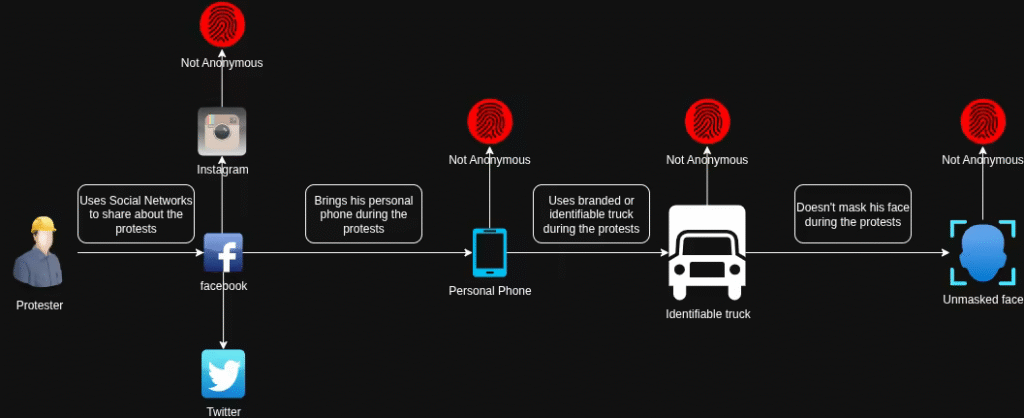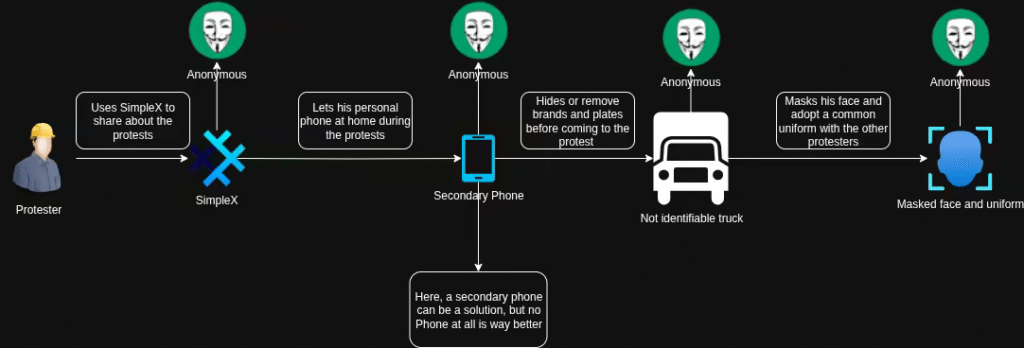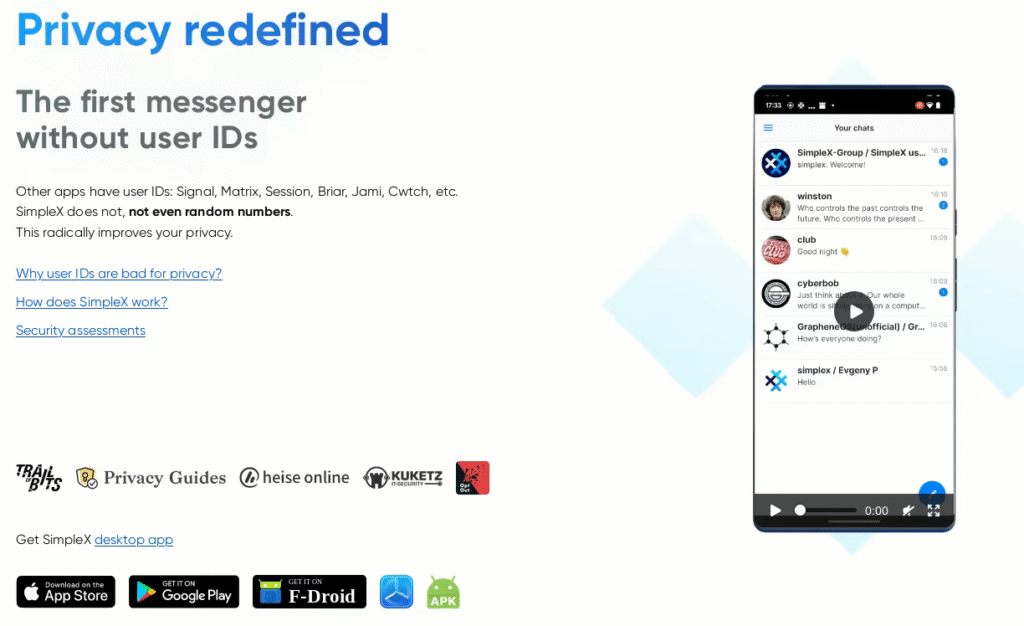This is a great post from the darknet’s OPSEC Bible. I watched the Canadian Freedom Convoy protests live when it was happening as well as the police brutality, and they were more passionate about their rights than most Americans. Which is sad as their Charter of Rights can be set aside for the crown’s interests at any time. Also, I think it was XMR Bizarre where I saw an add for articles by the OPSEC Bible, so some of this material is paid journalism. Also, Monero does have things going for it in regards to privacy, and why it’s being outlawed in the EU in 2027, but it’s still in development and has some things you need to be aware of for which I’ll do another post.
http://opbible7nans45sg33cbyeiwqmlp5fu7lklu6jd6f3mivrjeqadco5yd.onion//opsec/bankaccountfrozen/
Introduction
In early 2022, Canadian truckers organized a large-scale protest against COVID-19 restrictions and mandates, which began as a response to the vaccine mandate for cross-border truckers. Initially, the protest was focused on the mandate, but it quickly expanded to broader opposition to COVID-19-related restrictions.
The goal of the protest was to create a convoy of truckers that would travel to Ottawa and gather at Parliament Hill, attracting additional support from pedestrians who shared their opposition to the restrictions.

The core issue was that nearly 16,000 cross-border truckers who were not vaccinated were no longer allowed to work, putting a significant strain on their livelihoods and freedom, and triggering widespread discontent. As the protest gained momentum, it attracted support from a diverse range of individuals who felt their personal freedoms were being infringed upon.
The protests quickly became a significant political and economic issue, with disruptions to the flow of goods and services across the country. The Canadian government, concerned about the growing impact on the economy and public control, moved to put an end to the demonstrations. On February 14, 2022, the federal government invoked the Emergencies Act, granting law enforcement additional powers to suppress the protests.

By February 21, most of the blockades and protests had been dismantled through large-scale police operations, many of which involved the use of force. One of the most controversial actions was the freezing of bank accounts linked to protest organizers and participants, which sparked debates over the extent of government control and the infringement on civil liberties.

Emergency Act
Here, I’d like to take a closer look at the Emergencies Act and what it really means. As you know, many governments around the world used the COVID-19 crisis to invoke emergency powers and restrict individual freedoms. In some cases, those freedoms were never fully restored, even after the crisis ended. To illustrate this, let’s focus on the Canadian Emergencies Act and its consequences.
The Canadian Emergencies Act authorizes the government to “take special temporary measures that may not be appropriate in normal times.” This vague definition essentially gives the Canadian government the ability to suspend or override existing laws in order to maintain control over the population. In other words, the Act grants the government extraordinary powers to restrict individual freedoms whenever it deems necessary.
Under the Act, the Prime Minister and Cabinet can respond to four categories of emergencies: public welfare (natural disasters, disease), public order (civil unrest), international emergencies, and war emergencies.

In practice, however, it has functioned as a tool to suppress protest. By invoking it, the government can bypass democratic checks and limit dissent against unpopular decisions. It is, in essence, an authoritarian measure that raises serious questions about whether genuine democracy still exists. For example, under the Emergencies Act, police were given the authority to fine or jail individuals for participating in protests, even when those protests were peaceful and non-violent.
Even more controversially, the government empowered banks to freeze the accounts of protesters by applying the Proceeds of Crime and Terrorist Financing Act. In effect, ordinary citizens who were protesting suddenly found themselves treated as if they were terrorists or criminals. This redefinition of protest as a form of terrorism highlights the imbalance of power: the state retains total authority, while the population is left defenseless when challenging it.

As the state knows that blocking people’s money can be worse than sending them to jail, they had in this case the most efficient tool to regain control and power over them. This tactic has been historically used in the past: sometimes, starving people is far more effective than detaining them.
How the Police handled it
As previously mentioned, the Emergencies Act granted significant power to the police, and as you’re probably aware, police often have a tendency to exploit such authority. In situations like these, when the pressure is high, their actions can become even more questionable.
When we look at the events surrounding the Canadian trucker protests, we can see a clear example of this. Police didn’t hesitate to use force against peaceful civilians in an attempt to suppress the protests. Acting as an arm of the state, officers aggressively pushed back demonstrators, arresting many in the process, all in the name of “restoring order.” They even resorted to using pepper spray, further unbalancing the power dynamics.
One of the most striking moments during the protests was a message sent by the police to the protesters via Twitter:

While this might sound like a typical law enforcement statement, let me offer my personal thoughts. To me, this message reads almost like something a mafia boss might send to a rival gang during a turf war. The tone is almost cinematic, like a script for a crime thriller.
The reality on the ground was even more troubling. Police officers were armed with automatic weapons as though they were facing terrorists, when in fact, they were merely trying to control a protest. The imbalance of force was striking, and it painted a clear picture of how the state was willing to use excessive power against ordinary people who were simply expressing their dissatisfaction.

Unfortunately, part of the population opposed the protests, not because they supported the government’s restrictions, but simply because they were inconvenienced by the noise and “nuisance” created by the demonstrations. Rather than seeing the bigger picture about personal freedoms, they complained, which in turn gave even more legitimacy and power to the government and the police. By siding with authority out of frustration, they essentially weakened the protesters’ position. In moments like this, it becomes clear that for some people, comfort matters more than freedom.
The banks participation
What they did
As stated earlier, the Canadian government froze the bank accounts of people engaged in the protests, under the false pretext of “terrorism.” This action was a blatant attack on personal freedom, showing that the state has the power to cut people off from their own money and let them starve if necessary. This is exactly the kind of danger we warned about in our blog post on CBDCs: when the state holds absolute control over your finances, it can force you to comply with its will.

That’s precisely what happened here. By freezing protesters’ accounts, the government not only starved them economically but also pushed them into situations where they could no longer meet their legal obligations. Once your account is frozen, you cannot pay your rent, your mortgage, or any other contract you’ve signed, effectively turning law-abiding citizens into “criminals” overnight.
For example, imagine a trucker who bought a car through a financing plan. If his account is frozen, he cannot make his monthly payments, violating the contract with the seller. On paper, he becomes the one “at fault”, even though the state forced him into default.

Worse still, many of these people had families depending on these accounts to simply live: to buy food, pay bills, or access healthcare. Punishing children and families by cutting off financial access is not justice, it’s financial lawfare.
This kind of situation can lead people to be “debanked”. Debanking refers to the process of closing someone’s bank accounts because they are considered a “risk”. For example, if the state labels you a terrorist during a protest and orders the bank to freeze your accounts, the bank might decide to debank you as a “risky customer”. Once you’re debanked, it becomes extremely difficult to open an account at another bank, and this can result in losing everything, as most activities in modern society require a bank account. Have you ever tried renting a house without a bank account? Trust me, it severely limits your options.
Why they did it
The main question is: Why did the banks participate in this? Why did they accept to freeze accounts on the government’s command?
First, it’s important to understand that Canadian banks are highly regulated by the government. The government essentially sets the rules for banks to follow. If a bank decides to defy the government, the consequences can be severe: regulations could change to make it less profitable or, in extreme cases, force it to shut down. So, banks have little room to act independently without risking their financial stability.

Secondly, the relationship between banks and governments is interdependent. Banks provide capital to governments, while governments can offer money to banks through regulatory measures and loans. In Canada, the distinction between private and public banks isn’t as clear-cut as in some other countries; the government has a firm grip on the banking system.
In other words, when a Canadian citizen deposits their money in a Canadian bank, they’re essentially giving their money to the government. The state can exercise complete control over it, as demonstrated during the trucker protests.
Banks are not independent entities, they’re statist institutions that will always support government control measures, as long as it ensures their own survival and profitability. When push comes to shove, banks will choose the government’s favor over individual freedoms, because they have more to gain from the state’s power than from standing up for their customers’ rights.

How did they do it
In order to identify the individuals to target, multiple data sources were utilized.
First, the protesters and organizers were easily identified through social media activity. Many of them were openly discussing the protests and organizing operations online. This gave the government a direct window into the movement, enabling them to quickly pinpoint those involved and assess their level of participation.

Secondly, facial recognition (With cameras and drones usage) and license plate recognition technology were employed during the protests to identify participants who had not made their presence known on social networks. This allowed the government to track those who were attempting to stay anonymous by not posting online but still physically engaging in the protest. Additionally, phone tracking was used to trace participants’ locations in real-time, helping authorities monitor who was where and when.
Some protesters were arrested by the police during the protests, which led to the revelation of their identities.
Even donors who contributed to the protests were not safe. Those who used crowdfunding platforms and Bitcoin were easily traced back to their identities. Despite the supposed anonymity of Bitcoin, it was still possible to track transactions to specific individuals, especially if they were using centralized platforms that require identification.


Once these data sources were cross-referenced, the government compiled a list of targets and handed over the names to Canadian banks, which subsequently froze their accounts.
What this highlights is the importance of OPSEC, or, more precisely, the lack of it. Those involved failed to take the necessary precautions to protect their identity and digital footprint, allowing the government to leverage a combination of digital and physical surveillance tools to easily identify them. Without proper OPSEC, it becomes far too easy for anyone to be compromised, regardless of how well they think they are hiding.
How could the Truckers have protected themselves ?
As mentioned earlier, this all comes down to OPSEC. Below is a quick graph illustrating where they failed:

As you can see, the truckers made several mistakes regarding their OPSEC. By using statist platforms and personal information that was highly identifiable, they gave the state all the tools needed to track and punish them. But guess what? Even if they had made just one OPSEC mistake, they would have ended up in the same situation. Anonymity is a 1-0 thing: one mistake, and everything is compromised.
Here are some steps they could have taken to avoid this privacy breach:

When deciding to protest, it’s crucial to focus on your OPSEC. First and foremost, you must avoid any physical identification by authorities.
Additionally, never bring your personal phone to a protest, as these devices act as surveillance tools that can easily be used against you by the government.
If you need to plan anything before the protest, avoid using generic messaging apps. Instead, switch to SimpleX. It’s the best way to protect your conversations from government surveillance and to maintain anonymity online.

Anonymity is your best defense and the only way to avoid legal complications. To prevent the state from controlling your finances, it’s essential to embrace the circular economy and consider using privacy-focused cryptocurrencies like Monero.
With some governments moving towards Central Bank Digital Currencies (CBDCs), using them should be avoided at all costs. These state-controlled currencies give the government unprecedented power over your financial activities. Monero, on the other hand, is a decentralized cryptocurrency that operates outside of state control, offering anonymous transactions. If Monero had been used instead of Bitcoin and crowdfunding platforms during the Canadian Truckers’ protest, the state wouldn’t have been able to freeze donations or track donators.

But remember, protesting is not enough. If you’re truly aiming to challenge the state, you must also make sure you’re starving the parasite, just as the Canadian government starved the protesters by freezing their bank accounts.
Protesters talks
To give you an overview of the protesters’ motivations and perspectives during the Canadian Truckers’ protests, I’d like to share some quotes from interviews they gave.
“Three generations. We brought our children. I even brought my dog. We’re not going nowhere. We’re here to fight for our freedom, our rights, our ability to choose.”
“whether we want to do something or not. It’s my body, my temple, and I should have the right to choose what’s going in it.”
“In my opinion, the math hasn’t been adding up with the restrictions versus how bad the virus actually has turned out to be. As you look in history, any government that’s ever taken control and taken freedoms away from people never gives it back, and so we’re trying to cut this off before it gets really, really bad. That’s pretty much why we’re here.”
As you can see, it was all about freedom and human rights. And that is exactly what the Canadian government sought to suppress. This was not merely a matter of public health or managing an epidemic. It was about power and control. These protests arose because the state sought to restrict civilians’ right to work and their right to make decisions about their own bodies. Once again, this is an example of how governments are willing to curtail freedom, regardless of the cost.

Conclusion
As mentioned in this blog post, several OPSEC mistakes were made, which ultimately led to the Canadian Truckers being vulnerable to state intervention. These protests could have been far more effective had the protesters followed the OPSEC advice outlined earlier, reducing the state’s ability to target them. However, the violence remains a critical issue. The government granted the police expanded powers, allowing them to use force against peaceful protesters. This underscores why protesting alone is insufficient. States have less leverage when it comes to preventing population from starving them, compared to quelling protests.